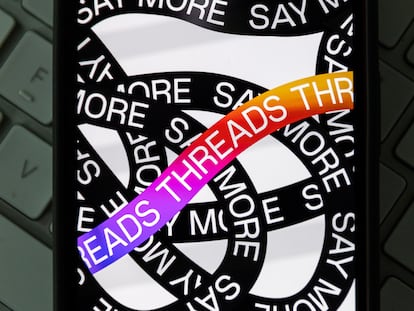Pros and cons of Threads, Meta’s Twitter
The social network with which Mark Zuckerberg pretends to replace X has better moderation and content control, but it lacks freshness and something essential: people

When Elon Musk took over Twitter, Mark Zuckerberg smelled blood. The co-founder of Tesla and SpaceX changed the cheerful little blue bird for a stern black X, a mutation that also serves as a metaphor for what the platform has become. After laying off 80% of the staff, Musk’s erratic management has affected the quality of the social network. Zuck saw the displeasure of many tweeters and decided to try to capitalize on it. Thus, Meta’s Threads was born, available since July in the United States and in Europe for the past couple of weeks.
The launch of Threads further fueled the tension between the two moguls. The platform reached 100 million users in five days, a mark on par with ChatGPT, the most successful app in history. But the progression slowed down. Almost half a year later, it has 141 million users, according to the figures provided by the consulting firms (Meta rejected this newspaper’s request to share its numbers). Musk threatened to sue Zuckerberg for plagiarism and for hiring former X employees — whom he had fired, anyway. They even challenged each other to a cage match, a hype fight that they stoked for months and that, of course, came to nothing.
Admittedly, Musk has a point: Threads does look like a copy of X. But is it, really?
I tested the new Meta social network for a week. Before detailing my findings, something to consider: there are many types of social media users. I am rather passive — I write little and read a lot. Would my experience have been different if I had been more active? It is not clear, and I hope this analysis sheds some light on why.
Getting started
The first step is to open an account. Threads offers the option of linking it with Instagram or creating a brand new one, albeit with fewer functionalities: you can view the content, share it and search for accounts, but not interact with them. I was not an Instagram user, but I changed this so that my Threads account was not limited.
The first few times you enter Threads, it seems like you are in X, especially if you access from your phone. The interface is somewhat cleaner and tidier. The buttons and features are practically identical to those of X. However, as soon as you start using it, you realize that you are on a different platform. There are no hashtags, or thematic groupings, which can complicate some searches. Also, each post fits up to 500 characters, compared to X’s 280.
Another key difference with X is that the content is more curated: the algorithm intervenes more, offering more contents related to your interests. One of the peculiarities of X is that the feed –—what you see — are the tweets of the accounts you follow, in strict reverse chronological order. In Threads, what you see when you open the app is not the latest, but what the algorithm considers that will be more interesting to you, no matter if it was published 10 minutes or six hours ago. That is not necessarily bad, as it enhances the dissemination capacity of the influencers and the accounts with the most followers. However, it also makes the different feeds look more similar to each other, and the chronologically constructed narrations are harder to follow.
Contents
I open Threads. A monkey rescues a kitten trapped in a well. I open X. A department store’s account tells me the price of the latest Apple Watch; a notice under the tweet informs me that this is promoted content. A little later, I try again. Threads: a girl in a miniskirt and high heels shows off her skills with a soccer ball. X: Foreign Affairs magazine shows an article about Javier Milei and what Argentina’s new president can mean for the country. Again. Threads: A series of kittens destroy a series of Christmas trees. X: I get hooked by a discussion among some of the so-called godfathers of artificial intelligence about whether this technology should be regulated or not.
It may seem trivial, but these examples summarize a good part of my experience with these social networks. Threads currently gives me viral, superficial content, exactly the opposite of what I get in X. It could be my fault: I still follow few accounts, so the “For you” feed tends to favor the posts that perform best on the platform. On the other hand, there is no advertising, one of the most annoying parts of X since Musk launched the subscription system (I am among those who don’t pay).
😂
— Elon Musk (@elonmusk) July 6, 2023
All in all, the platform formerly known as Twitter is still where the interesting discussions take place. The service has declined, the tension has increased, but everyone is still there. Twitter managed to become the great digital public square of our time, and right now it seems hard to believe that tweeters will move to another platform. Time will tell.
The porn test
In addition to being free and having no ads, Threads has another great advantage over the current X: content moderation. According to Meta sources, Threads is subject to the same controls as Instagram, which combines automatic tools (machine learning engines that look for inappropriate contents in order to block them) and human supervision (users can report posts, which will be manually reviewed and removed if necessary) to fight hate speech and other illegal contents. If someone violates the rules repeatedly, their account will be closed.
The result is evident. Finding reportable content is not easy. If you open Threads and look for “pizzagate” (the bizarre conspiracy theory launched in 2016 according to which members of the Democratic Party had an alleged network of human trafficking and child exploitation operating in basements and restaurants), a warning will let you know that the search could be related to harmful content, and a link will offer to take you to a website explaining what QAnon is and why it is problematic. On X, the same search brings up dozens of accounts that support pizzagate.
But the litmus test to see if a social network is broken or not is pornography. In Threads, that search returns no results. In X, all you need to find explicit sex movies (up to two hours long) is the right keyword. Since buying Twitter, Musk assured that there would be no censorship of any kind on his platform. The decision to allow porn has cost him money, driving away advertisers looking to invest in family-friendly environments.
On Threads, when you want to follow a profile that Meta has identified as a source of misinformation, a warning pops up, asking if you are sure you want to follow that account and explaining that it has posted false information or gone against the platform’s community guidelines. Today, that is unthinkable in X.
In conclusion
Technically, Threads is a good platform. Of course, the fact that it is another version of X is undeniable, which on the other hand is nothing new: Bluesky, Mastodon and even Truth Social, Donald Trump’s platform, are all copies of the original Twitter. It does have things that X used to have and now we miss, such as consistent content moderation. And, above all, the potential to attract 2 billion Instagram users.
However, it lacks something essential: people. Perhaps for that reason, and due to the structure of the platform itself, which prioritizes the algorithm a little more, it is difficult to find really interesting threads on Threads. Still, time will tell if it is yet another copy of the old Twitter, or if we are finally before its generational replacement.
Sign up for our weekly newsletter to get more English-language news coverage from EL PAÍS USA Edition
Tu suscripción se está usando en otro dispositivo
¿Quieres añadir otro usuario a tu suscripción?
Si continúas leyendo en este dispositivo, no se podrá leer en el otro.
FlechaTu suscripción se está usando en otro dispositivo y solo puedes acceder a EL PAÍS desde un dispositivo a la vez.
Si quieres compartir tu cuenta, cambia tu suscripción a la modalidad Premium, así podrás añadir otro usuario. Cada uno accederá con su propia cuenta de email, lo que os permitirá personalizar vuestra experiencia en EL PAÍS.
¿Tienes una suscripción de empresa? Accede aquí para contratar más cuentas.
En el caso de no saber quién está usando tu cuenta, te recomendamos cambiar tu contraseña aquí.
Si decides continuar compartiendo tu cuenta, este mensaje se mostrará en tu dispositivo y en el de la otra persona que está usando tu cuenta de forma indefinida, afectando a tu experiencia de lectura. Puedes consultar aquí los términos y condiciones de la suscripción digital.
More information
Archived In
Últimas noticias
NASA discovers Titan doesn’t have an ocean, but a ‘slushy ice layer’ that increases possibility of life
Innocence lost in the forest of the child soldiers: ‘Each leader of the armed group had his girls’
‘Fallout’ or how the world’s largest company turned an anti-capitalist apocalyptic Western into a phenomenon
From inflation to defending migrants: Eileen Higgins and Zohran Mamdani inaugurate the new Democratic resistance against Trump
Most viewed
- ‘El Limones’ and the growing union disguise of Mexican organized crime
- Christian Louboutin: ‘Young people don’t want to be like their parents. And if their parents wear sneakers, they’re going to look for something else’
- The low-cost creative revolution: How technology is making art accessible to everyone
- ‘We are dying’: Cuba sinks into a health crisis amid medicine shortages and misdiagnosis
- Liset Menéndez de la Prida, neuroscientist: ‘It’s not normal to constantly seek pleasure; it’s important to be bored, to be calm’











































